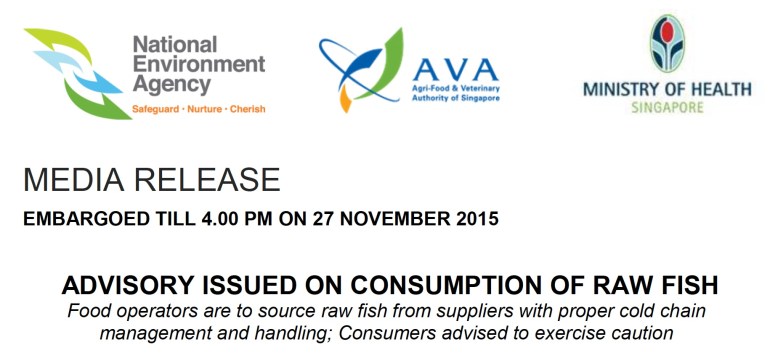Group B Streptococcus (Singapore) – Update 5, 2015
After the fall back to baseline of severe Group B streptococcal infections in August, I did not expect to write another post of GBS so soon. But it just goes to show that the management of outbreaks and implementation of policies are both not always straightforward.
An excellent recap of the GBS outbreak in Singapore this year can be found at the official blog of SGH Diagnostic Bacteriology. Briefly, unusually severe GBS infections were noticed in many local hospitals between March and July 2015, although there is good evidence (soon to be published, hopefully) now to suggest that the outbreak started earlier. The majority of these cases were linked to the consumption of raw freshwater fish sold in porridge stalls in hawker centres, and were caused by a single strain of GBS, sequence type (ST) 283. Prior to our outbreak, ST283 GBS had previously been reported to cause severe disease in farmed fish in Asia, and sporadic severe cases of infection had also been reported in non-pregnant adults in Hong Kong. MOH, NEA and AVA put forward a joint statement on 24th July 2015 requesting that stall holders stop using two types of fish – Song fish (bighead carp) and toman fish (snakehead) – for raw fish consumption. The effect was dramatic, and most of us believed that the outbreak was over.
Then earlier this month, a middle-aged previously healthy man slipped into a coma after developing severe GBS brain infection three days following the consumption of raw fish from a porridge stall in Tiong Bahru.A Lianhe Wanbao report (I do not have the link, but a photo is provided below, courtesy of the SGH Diagnostic Bacteriology bloggers) suggested that the fish in question was “grass carp”, therefore technically not a violation of the MOH/NEA/AVA recommendations. Given the heightened awareness, this case was quickly picked up by the doctors at KTPH and reported to MOH.

Lianhe Wanbao report on the GBS meningoencephalitis case at KTPH this month
It is now clear on hindsight that the earlier MOH/NEA/AVA recommendations in July were precise (targeting only 2 types of fish) but inadequate. A new joint advisory has just been issued by the three government agencies with regards to the handling of fish for raw consumption. In essence, standards for selling fish for raw consumption became quite a bit higher, with requirements for health certificates for the fish, separate packing (from other fish not for raw consumption), proper cold chain in the logistics cycle, and hygienic handling practices at the retail site including separate chopping block and preparatory utensils. This advisory applies to both salt- and freshwater fish, and the requirements are probably too difficult to meet within the hawker stall setting, hence I believe that the hawker stall yu-sheng will become a thing of the past.

Screen capture of the MOH/NEA/AVA advisory on 27 November 2015
Why not just ban all food establishments from selling raw freshwater fish for consumption? This was my first inclination after understanding that ST283 GBS was associated with Song fish and Toman. It has also been the practice in Hong Kong, where “Chinese yu sheng” has been prohibited from sale for 30 years now, give or take a few years. But after a discussion with a senior NEA official who was kind enough to provide quite a bit of time and information, I see that this current approach – providing standards for all fish for raw consumption – is certainly more comprehensive. There are a whole host of other infections that can also be transmitted to humans from improper handling of saltwater fish (take not, sushi and sashimi lovers!), and it is timely to have an advisory that covers for these possibilities as well.
There is still a potential loophole in this new advisory, however. Because specific types of fish are not named now, it is theoretically possible for a restaurant or stall that is determined enough to sell raw Song fish and Toman (or tilapia, which is already being used for sushi and has been found locally to also carry ST283 GBS) for consumption, ticking off all the requisite boxes. Most of the requirements for fish preparation for raw consumption are specific to the prevention of parasitic infections (cold chain) and cross-contamination of the fish, and may prevent overgrowth of existing bacteria on the fish (again via the cold chain). Whether this is sufficient to completely prevent ST283 GBS infections (which appear to colonise the types of freshwater fish listed above) remains unclear.
[…] recap, unusually severe GBS infections were noticed in many local hospitals between March and July …. The majority of these cases were linked to the consumption of raw freshwater fish sold in porridge […]
LikeLike